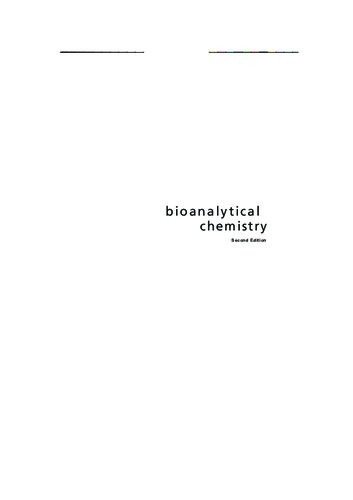

Most ebook files are in PDF format, so you can easily read them using various software such as Foxit Reader or directly on the Google Chrome browser.
Some ebook files are released by publishers in other formats such as .awz, .mobi, .epub, .fb2, etc. You may need to install specific software to read these formats on mobile/PC, such as Calibre.
Please read the tutorial at this link. https://ebooknice.com/page/post?id=faq
We offer FREE conversion to the popular formats you request; however, this may take some time. Therefore, right after payment, please email us, and we will try to provide the service as quickly as possible.
For some exceptional file formats or broken links (if any), please refrain from opening any disputes. Instead, email us first, and we will try to assist within a maximum of 6 hours.
EbookNice Team

Status:
Available4.4
31 reviews(Ebook) Bioanalytical Chemistry 2nd Edition by Andreas Manz, Petra S Dittrich, Nicole Pamme, Dimitri Iossifidis - Ebook PDF Instant Download/Delivery: 9781783266715 ,1783266716
Full download (Ebook) Bioanalytical Chemistry 2nd Edition after payment
Product details:
ISBN 10: 1783266716
ISBN 13: 9781783266715
Author: Andreas Manz, Petra S Dittrich, Nicole Pamme, Dimitri Iossifidis
(Ebook) Bioanalytical Chemistry 2nd Edition Table of contents:
Chapter 1 Biomolecules
1.1 Amino Acids, Peptides and Proteins
1.1.1 Amino Acids
1.1.2 Peptides and Proteins
1.2 Nucleic Acids
1.2.1 The Structure of Nucleic Acids
1.2.2 Synthesis of Proteins
1.3 Biomolecules in Analytical Chemistry
1.3.1 Classical Analytical Chemistry
1.3.2 Limitations of Classical Analytical Chemistry
1.3.3 Bioanalytical Chemistry
Summary
References
Chapter 2 Chromatography
2.1 The Principle of Chromatography
2.2 Basic Chromatographic Theory
2.3 Liquid Chromatography Techniques for Bioanalysis
2.3.1 Liquid Chromatography Instrumentation
2.3.2 Reversed-Phase Liquid Chromatography (RP-LC)
2.3.3 Hydrophilic Interaction Liquid Chromatography (HILIC)
2.3.4 Ion-Exchange Chromatography
2.3.5 Affinity Chromatography
2.3.6 Size Exclusion Chromatography (SEC)
Summary
References
Chapter 3 Electrophoresis
3.1 Principle and Theory of Electrophoresis
3.1.1 Electrophoretic Mobility
3.1.2 Joule Heating
3.1.3 Electroosmotic Flow (EOF)
3.1.4 Separation Efficiency and Resolution
3.2 Gel Electrophoresis (GE)
3.2.1 Instrumentation for Gel Electrophoresis
3.2.2 Modes of Gel Electrophoresis
3.2.3 Sodium-Dodecyl Sulfate — Polyacryl Amide Gel Electrophoresis (SDS-PAGE)
3.2.4 Isoelectric Focussing (IEF)
3.2.5 Two-Dimensional Gel Electrophoresis (2D-GE)
3.3 Capillary Electrophoresis (CE)
3.3.1 Capillary Electrophoresis Instrumentation
3.3.2 Capillary Zone Electrophoresis (CZE)
3.3.3 Capillary Isoelectric Focussing (CIEF)
3.3.4 Micellar Electrokinetic Chromatography (MEKC)
3.3.5 Capillary Gel Electrophoresis (CGE)
Summary
References
Chapter 4 Mass Spectrometry
4.1 The Principle of Mass Spectrometry
4.1.1 Ionisation
4.1.2 Mass Analyser
4.1.3 Detector
4.2 Matrix-Assisted Laser Desorption Ionisation — Time-of-Flight Mass Spectrometry (MALDI-TOF-MS)
4.2.1 Ionisation Principle
4.2.2 Mass Analysis in Time-of-Flight Analyser
4.2.3 Detection of Ions
4.2.4 Resolution
4.2.5 Sample Pre-treatment
4.2.6 Applications of MALDI
4.3 Electrospray Ionisation Mass Spectrometry (ESI-MS)
4.3.1 Ionisation Principle
4.3.2 ESI-Source and Interface
4.3.3 Quadrupole Analyser
4.3.4 Applications of ESI-MS
Summary
References
Chapter 5 Optical Spectroscopy
5.1 Absorption of UV and Visible Light
5.1.1 Basic Principles of Absorption Measurements
5.2 Fundamentals of Fluorescence Spectroscopy
5.2.1 Introduction to Fluorescence
5.2.2 Instrumentation
5.2.3 Fluorescence Parameters
5.2.4 Signal Intensity
5.2.5 Fluorophores and Labelling Strategies
5.2.6 Fluorescence Imaging
Summary
References
Chapter 6 Molecular Recognition in Immunoassays, Biosensors, DNA-Arrays and Pyrosequencing
6.1 Bioassays
6.1.1 Antibodies
6.1.2 Antigens
6.1.3 Antibody-Antigen-Complex Formation
6.1.4 Assay Formats
6.1.5 Home Pregnancy Test
6.1.6 Enzyme Immunoassays (EI and ELISA)
6.2 Biosensors
6.2.1 The Bioreceptor
6.2.2 The Transducer
6.2.3 Blood Glucose Sensor
6.3 DNA Binding Arrays
6.3.1 Principle of DNA-Arrays
6.3.2 Fabrication of DNA-Arrays
6.3.3 Development and Analysis of a DNA-Array
6.3.4 Sequencing of DNA with Arrays
6.3.5 Other Applications of DNA-Arrays
6.4 DNA Identification by Pyrosequencing
6.4.1 The Principle of Pyrosequencing
6.4.2 Sample Preparation and Instrumentation
6.4.3 Applications of Pyrosequencing
Summary
References
Chapter 7 Nucleic Acid Analysis
7.1 Extraction and Isolation of Nucleic Acids
7.1.1 CsCl Density Gradient Centrifugation
7.1.2 Total Cellular DNA Isolation
7.1.3 RNA Isolation — the Proteinase K Method
7.2 Nucleic Acid Amplification — the Polymerase Chain Reaction (PCR)
7.2.1 The Principle of PCR
7.2.2 The Rate of Amplification During a PCR
7.2.3 Reagents for PCR
7.2.4 Real-Time PCR
7.2.5 Reverse Transcriptase — PCR (RT-PCR)
7.3 Nucleic Acid Sequencing
7.3.1 The use of Restriction Enzymes in Sequencing
7.3.2 The Chemical Cleavage Method (Maxam–Gilbert Method)
7.3.3 The Chain Terminator Method (Sanger or Dideoxy Method)
7.4 RNA-Sequencing
Summary
References
Chapter 8 Protein Analysis
8.1 Protein Sequencing Strategy
8.2 End-Group Analysis
8.2.1 N-terminal Analysis (Edman Degradation)
8.2.2 C-terminal Analysis
8.3 Disulfide-Bond Cleavage
8.4 Separation and Molecular Weight Determination of the Subunits
8.5 Amino Acid Composition
8.6 Cleavage of Specific Peptide Bond
8.6.1 Enzymatic Fragmentation
8.6.2 Chemical Fragmentation Methods
8.7 Sequence Determination
8.8 Ordering of Peptide-Fragments
8.9 Determination of Disulfide Bond Positions
8.10 Protein Sequencing by Mass Spectrometry
Summary
References
Index
People also search for (Ebook) Bioanalytical Chemistry 2nd Edition:
kaisong yuan analytical and bioanalytical chemistry
what is bioanalytical techniques
northeastern bioanalytical chemistry
bioanalytical chemistry northeastern
bioanalytical chemistry and pharmaceutical analysis m sc
Tags: Andreas Manz, Petra S Dittrich, Nicole Pamme, Dimitri Iossifidis, Bioanalytical Chemistry